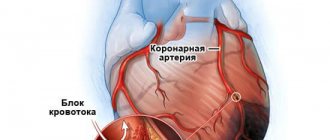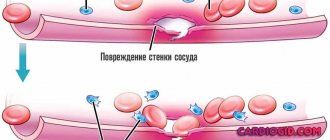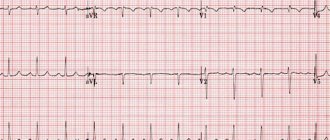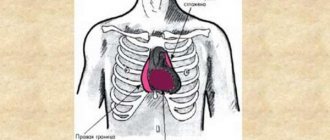For our body to be healthy, the heart must perform its functions smoothly and be of normal size. Changes in heart size can be caused by disease - bovine heart. Today, this problem is very relevant, since advertising of alcoholic beverages is popular, and accordingly, beer lovers are only growing every year. This may also be a normal condition for anyone involved in professional sports.
This disease can be congenital or acquired and is very dangerous. Even qualified specialists may not determine the cause of the disease the first time. What kind of disease is this, what are the first signs and main methods of treatment, we will tell you all this below.
Characteristics of the disease
Bovine heart
An increase in the size of the heart is called cardiomegaly. The mechanism of enlargement of this organ may be associated with enlargement of the ventricles (one or both at once), their expansion (dilatation), neoplastic processes and accumulation of metabolic products in the cavity of the organ.
In this situation, true cardiomegaly develops. Often, an enlarged heart develops in a healthy person against the background of increased stress when carrying a child. Cardiomegaly is very often detected in athletes. It is possible to accurately determine the cause of a large heart only through special instrumental research methods.
In humans, the size of the heart can vary within small limits. It is known that men have slightly larger heart sizes than women. In men aged 20-30 years, the heart volume is about 760 cm³, in women - 580 cm³.
The size of the heart is proportional to the weight of the human body. The features of the chest are of no small importance. An enlarged heart does not always indicate that a person is sick. A small heart is also not always the norm. Currently, the maximum heart size has not been established. It is individual for each person.
Disease
The heart is the most important organ that ensures the normal functioning of all systems. When it increases in size, it is customary to talk about a pathology such as cardiomegaly. Another name for the disease is “bull heart”.
Pathology poses a threat not only to health, but also to human life. If you consult a doctor in a timely manner, the prognosis is usually favorable.
Currently, there are effective conservative and surgical treatment methods.
Pathogenesis
The size of the heart directly depends on a person’s body weight. In addition, the anatomical features of the chest are important. In young men, the heart volume is approximately 760 cm3, in women - 580 cm3. With age, the size of the muscle may change slightly, which is not a pathological process.
Under the influence of various unfavorable factors, cardiomegaly can occur.
It is customary to talk about “bull’s heart” disease when the size of the organ in adults exceeds 11 x 11 x 8.5 cm, in children – 3 x 4 x 1.8 cm.
As a rule, the pathogenesis of the disease is based on the enlargement of one or both ventricles, their expansion, accumulation of metabolic end products in the cavity, and neoplastic processes.
Etiology
Pathology is not an independent disease. The process of development of cardiomegaly begins against the background of other cardiovascular disorders or physiological changes. The main causes of bull's heart disease are listed below.
1. Congenital:
- Genetic predisposition.
- Congenital heart defects.
- Abnormally located valve attachment points.
- Unhealthy lifestyle of a woman during pregnancy (unbalanced diet, uncontrolled use of medications, smoking, use of drugs and alcoholic beverages, injuries, infectious diseases, living in a region with an unfavorable environmental situation).
2. Purchased:
- Atherosclerosis.
- Neoplasms of both benign and malignant nature.
- Hypertension.
- Heart valve defects.
- Viral myocarditis.
- Cardiomyopathy.
- Increased blood pressure in the pulmonary circulation.
- Cardiac ischemia.
- Arrhythmia.
- Diabetes.
- Iron-deficiency anemia.
- Cardiomyodystrophy.
- Tobacco smoking.
- Regular consumption of alcoholic beverages.
- Hormonal imbalance.
- Pathologies of the thyroid gland.
- Long-term use of certain medications (in particular, Adriamycin, Methyldopa, Idarubicin and Novocainamide).
- Impaired kidney function.
- Pericarditis.
- Endocarditis.
Regardless of the cause of the disease, “bull’s heart”, treatment of the pathology cannot be delayed. Although the disease develops very slowly, it leads to irreversible consequences, in particular death.
Risk factors
Often the disease occurs due to non-pathological causes. Bull's heart disease is seen in Wiki as a problem that occurs primarily in athletes. Doctors also say that the main risk factor is regular and high-intensity physical activity.
What is the reason for this? In any athlete, the heart muscle gets used to working in an increased mode over time. Its dimensions are also increasing. The development of bull's heart disease occurs if a person stops exercising even for a short time. In addition, no athlete is immune from injuries and pathologies, the presence of which does not allow regular exercise.
As a result, the heart cannot decrease in size and continues to work at an increased rate. But at the same time, the body no longer needs it. The consequence is stagnation of liquid connective tissue, oxygen starvation, and heart failure.
In addition, allergies are a risk factor. Even intolerance to any food product can become an impetus for the development of bull's heart disease. This is explained by the fact that the antibodies produced provoke sensitization, which often leads to autoimmune conditions. In this case, the prognosis is considered unfavorable.
As mentioned above, one of the reasons is alcoholism. According to numerous studies, beer drinkers are most susceptible to pathology.
Clinical manifestations
An enlarged heart in itself is a symptom of one of the above diseases. As organ parameters change, a person develops the following alarming signs:
- Rhythm disturbances.
- Increased blood pressure.
- Increased heart rate.
- Shortness of breath during physical activity.
- Painful sensations in the chest area.
- Excessive sweating.
These clinical manifestations are not specific, but if they occur, you should consult a physician or cardiologist as soon as possible.
Symptoms of bull's heart disease in newborns:
- Paleness of the skin.
- Blueness around the mouth and around the eyes.
- Shallow breathing. It's unrhythmic.
- Cardiopalmus.
- Apathy.
- Lethargy.
- Lack of appetite.
- Edema of the lower extremities.
- Excessive sweating.
Regardless of the causes and symptoms of bull's heart disease, if alarming signs appear, the child should be shown to a pediatrician and cardiologist as soon as possible. Any delay could cost the baby his life. According to statistics, the survival rate among children is 50%.
Conservative treatment methods
It is important to understand that cardiomegaly is not an independent disease. In this regard, it is initially necessary to get rid of the cause of its development. The goal of treatment is to stop the progression of the disease. At present, it is only possible to prevent further deformation of the heart.
The classic regimen of drug treatment for pathology involves taking or administering the following drugs:
- Antihypertensive drugs.
- Anticoagulants. Active components prevent the formation of blood clots.
- Beta blockers. Drugs belonging to this group normalize the functioning of the heart muscle.
- Diuretics. Prescribed if excess sodium is detected in the patient’s body.
Most patients experience surges in blood pressure. In such cases, additional drugs are prescribed that normalize the indicator. If there are other concomitant pathologies, an appropriate treatment regimen is drawn up.
Antibacterial therapy is indicated only if an inflammatory process occurs in the patient’s body.
Drug treatment will not lead to a positive result if a person does not follow the principles of a healthy lifestyle. Doctors recommend that all patients stop smoking and drinking alcohol. In addition, it is necessary to regularly expose the body to moderate physical activity.
Surgical intervention
If conservative methods are ineffective, the doctor evaluates the advisability of surgical treatment. The goal of the intervention is to normalize or maintain the functioning of the heart muscle.
Currently, the following surgical treatment methods are used in practice:
- Valve implantation.
- Installation of a pacemaker.
- Coronary bypass surgery.
- Installation of devices that provide auxiliary blood circulation.
In most cases, people's quality of life improves significantly after surgery. Often the progression of the pathology can be stopped.
Adjusting your diet
All patients must follow a diet. Basic principles of therapeutic nutrition:
- For breakfast you should eat porridge from all kinds of cereals. The ideal dessert is fruit.
- For lunch, you need to eat foods high in protein and foods of plant origin.
- Dinner should consist exclusively of low-calorie dishes.
- In between meals, you can snack on vegetables, fruits and low-fat yogurt.
If you have cardiomegaly, it is forbidden to consume canned food, sugar, fatty foods, and animal products.
Forecast
The outcome of the disease directly depends on the timeliness of visiting a doctor. With proper treatment, the deformation of the organ stops. But in order to prevent your health from deteriorating, you must constantly follow the recommendations of doctors.
Regarding how many people live with bull's heart disease. Children have a poor prognosis. Survival rate is 50%. In this case, death most often occurs before the age of three months. Some of the survivors recover completely, while others show signs of heart failure.
In adults, the prognosis is more favorable. An exception is cardiomegaly, the development of which was provoked by the consumption of alcoholic beverages. More than a third of alcoholics die within 3 years after developing the disease. The main causes of death are thromboembolism and heart failure.
Causes of pathology
The most important organ that ensures the vital functions of the entire body consists of 4 chambers: two ventricles and two atria. There are two sections of the heart - right and left, each of which includes an atrium and a ventricle. Normally, the boundaries of the heart change throughout life.
People who play sports experience an increase in its size, which is considered a completely natural process and does not cause any cause for concern. The weight of a man's heart is 332 grams, a woman's - 253 grams. An enlarged heart is observed when the myocardium grows and (or) expands its cavity.
Most often, the organ enlarges to the left, which is observed in many diseases: hypertension, stagnation of blood in the systemic circulation, heart defects. Enlargement of all parts of the organ is dangerous. This condition is called “bull’s heart”, and only surgical intervention can improve a person’s quality of life. The reasons influencing the enlargement of the organ are:
- Hypertonic disease. An increase in pressure leads to changes in the cardiovascular system: vascular tone increases, the thickness of the muscle layer increases, and the systemic circulation suffers.
- Coronary heart disease: angina pectoris, myocardial infarction. Oxygen starvation of the organ tissues occurs with the death of their cells and replacement with connective tissue, which leads to an increase in the size of its left section.
- Rheumatic heart disease. It is a consequence of tonsillitis (frequent tonsillitis). Rheumatic disease is manifested by an inflammatory process occurring in the tissues of the organ. As a result, the valves suffer and defects form.
- Myocarditis.
- Renal dysfunction.
- Alcohol abuse. The most common example is alcoholic cardiomyopathy.
- Smoking.
- Acute pericarditis (inflammation of the serous membrane).
- Congenital heart defects.
The heart does not enlarge so often due to:
- Muscular dystrophy. Nerves and muscles are damaged.
- Tricuspid valve insufficiency. When overloaded with blood volume, the right ventricle and atrium enlarge. With defective valves on the left side of the heart, pulmonary hypertension causes a secondary enlargement of the heart muscle on the right.
- Hypertrophic cardiomyopathy. The reasons for the slight increase in size lie in dystrophy of the heart muscles with the presence of asymmetric and disproportionate ventricular hypertrophy. In this case, an obstacle to the removal of blood occurs (or does not arise).
- Infiltrative-restrictive cardiomyopathy. The heart muscle enlarges because the filling of both ventricles is impaired.
- Cardiocynomatosis. Enlargement of the heart muscle occurs due to infiltration of the myocardium or pericardium against the background of breast or lung cancer.
- Radiation myocarditis. Myocardial fibrosis and dilatation of the heart chambers occur with occasional irradiation of the sternum.
- Bacterial endocarditis. A large heart occurs if there is severe insufficiency: mintral or aortic.
- Infrequently, the walls of the central circulatory organ become enlarged due to tocoplasmosis. This disease is caused by protozoa. Idiopathic cardiomyopathy may be misdiagnosed. And also due to streptococcal infection in acute rheumatism (rheumatic carditis).
- Endocrine disorders enlarge the heart. Hyperthyroidism increases heart rate, stroke volume, and output, while hypothyroidism increases bradycardia and pericardial effusion.
Due to rheumatoid arthritis, a disease such as pericarditis occurs and pericardial effusion is noted. Against the background of systemic lupus erythematosus, lesions of any cardiac structure are noted, including valves and pericardium, the conduction system, and coronary arteries.
The presence of pathology in close relatives is considered a risk factor, therefore, under certain conditions, the disease can manifest itself in other family members. A common cause of changes in the heart muscle is an increase in pressure (above 140/90 mm Hg), which has a detrimental effect on the state of the cardiovascular system and in some cases leads to an enlargement of the organ up to the “bull heart”.
Congenital heart disease is of great importance. Today, it is treated in the first years of life, but there are also forms that are discovered only at an older age. An example is non-closure of the interventricular septum. The left ventricle contains oxygen-rich blood (arterial), and the right ventricle contains carbon dioxide (venous).
Normally, the blood does not mix, but with pathology of the interventricular septum, blood flows from the left ventricle to the right. There are different variations in the size of the defect. Improper distribution of blood within the organ leads to its enlargement.
What causes a greatly enlarged heart?
For adequate functioning, the size of the heart must be within normal limits. Only under this condition does the organ fully pump blood. If its parts are hypertrophied, functional ability decreases. In cardiology, when the organ is greatly enlarged, the term cardiomegaly is used. Doctors call it bull's heart.
Causes:
- aortic valve insufficiency,
- birth defects,
- hypertonic disease.
Attention! Cardiomegaly develops slowly with frequent beer consumption. That's why doctors call it beer heart.
When drinking 3 liters of alcohol per day, the heart muscle is overloaded. The organ has to pump much more fluid. And then compensatory capabilities are activated - the heart is forced to double in size. His chambers are expanding.
Although the size of the organ increases during illness, the volume of working mass decreases sharply. Cardiocyte muscle cells are replaced by dense connective tissue.
Attention! With bovine heart, the muscle is unable to stretch. Therefore, it does not have enough power for a full contraction. As a result, the myocardium becomes flabby and wears out. There is a danger of developing heart failure.
At the beginning of the disease, the organ copes with the load, and its owner does not experience any difficulties. However, there comes a period when the weakened heart muscle is not able to push out a normal volume of blood with each contraction. This means that fluid stagnates in the legs, lungs, and liver. In medical terms, heart failure begins to develop. Signs include shortness of breath, swelling of the legs, accumulation of fluid in the abdomen (ascites). The liver increases in size, and various heart rhythm disturbances occur.
Most beer drinkers get fat because the “drink” is very high in calories. Obesity further overloads the pumping function.
Who may develop bovine heart disease?
As mentioned above, beer lovers are susceptible to this disease. But not only these people can have stretched heart muscles.
Some categories of athletes may also suffer from this disease. Various workouts and loads keep the heart in good shape. But if you suddenly stop exercising, cardiovascular problems may arise. The heart muscle may become stretched and function weakened.
This is due to the fact that when an athlete trains (swims, exercises, etc.), the heart muscle gets used to this pace and begins to work harder, and cardiac mass also increases. But if a person abruptly stops training, the heart, accustomed to this pace, cannot decrease in size on its own.
It works as before, but the person no longer needs it, and blood stagnation appears, less oxygen begins to be produced, which leads to oxygen starvation. As a result, heart failure occurs. This condition can be observed not only among athletes and beer drinkers. People with rheumatism or collagenosis may be susceptible to this disease.
Even something as harmless as a strawberry allergy can ultimately lead to bull's heart disease. Antibodies that are produced during allergies provoke constant sensitization of the body, which can lead to an autoimmune condition. If the disease is congenital, the prognosis for recovery is unfavorable.
Acquired cardiomegaly occurs with cardiovascular diseases of the heart and other organs. Most often, heart enlargement can be observed with ischemic heart disease, emphysema, hypertension and heart defects. Inflammatory processes in the heart caused by diseases such as tonsillitis, rheumatism, scarlet fever, and rheumatic carditis can contribute to the diagnosis of “bull’s heart.”
Alcohol poisoning can cause enlargement of the heart muscle. Excessive or improper use of medications is a provocateur of cardiomegaly. A disease such as acute pericarditis causes an enlarged heart. Fluid accumulates in the pericardium, which can cause the heart muscle to enlarge.
Causes
The pathology is observed in people who engage in professional sports. Due to physical activity, the cardiovascular system works harder and pumps a larger volume of blood - this factor leads to an increase in heart weight. With a constant load, the athlete’s condition is considered normal; after stopping training, there is a risk of pathology developing. Other causes of cardiomegaly:
- heredity;
- fetal malformations;
- abnormalities of the heart structure, valve defects;
- chronic hypertension;
- carditis – inflammation of the heart muscle;
- long-term use of drugs toxic to the myocardium - drugs from the groups of barbiturates, cytostatics, antiarrhythmics;
- cardiomyopathy.
At risk are patients with impaired renal function and diseases of the cardiovascular system. In childhood, acquired pathology is associated with recent infectious and viral diseases. The presence of bad habits, stress, overwork, and a sedentary lifestyle contribute to the manifestation of ox heart syndrome.
Important! An additional provoking factor is an enlarged heart in close relatives.
Enlarged heart in a child
As a rule, an enlarged heart is detected by chance during a routine examination and chest x-ray. The diagnosis of an enlarged heart, or cardiomegaly, shocks parents. Cardiomegaly can be primary or secondary. Secondary cardiomegaly develops against the background of infectious diseases, toxic lesions, and also with respiratory failure.
But the exact causes of primary cardiomegaly remain not fully known. An enlarged heart is quite difficult to determine for a non-specialist, which is why parents are surprised by the diagnosis. And, indeed, the symptoms that accompany the disease are rapid heartbeat, rapid breathing, cyanosis of the nasolabial triangle, swelling, pale skin, and lack of appetite.
Such symptoms can accompany various diseases, so it doesn’t even occur to many parents that their child has an enlarged heart. Children's hearts beat much faster than adults'. If the beat frequency exceeds 160 beats per minute, then this is already an alarming sign.
But, if parents cannot measure the heart rate themselves, then they can monitor the rhythm of breathing. With cardiomegaly, breathing not only becomes more frequent, but also the rhythm is disturbed, it becomes shallow with missed breaths.
The following pathologies can lead to an enlargement and expansion of the heart in a child:
- Congenital heart defect. An enlarged heart is caused by such defects as patent ductus arteriosus, Ebstein's anomaly, aortic stenosis, tetralogy of Fallot, pulmonary stenosis, atrial septal defect and others.
- An acquired defect caused by bacterial endocarditis or rheumatism. As a result of inflammation of the inner lining of the heart, the valves are damaged, which leads to problems in the functioning of the heart. The disease is manifested by fever, weakness, abnormal noises and other symptoms.
- Myocarditis. This fairly common disease is an inflammation of the heart muscle caused by viruses, bacteria or other pathogens.
- Cardiomyopathy. This is a genetically determined lesion of the heart, in which there may be thickening of its walls (this cardiomyopathy is called hypertrophic) or expansion of the cavities with thinning of the walls (this is a manifestation of dilated cardiomyopathy).
- Heart surgery. In 20-40% of children who have undergone such an intervention, cardiotomy syndrome may develop 2-3 weeks after surgery. The pathology is manifested by severe weakness, fever, chest pain, breathing problems and heart murmurs.
- An oncological process in the heart or the development of a benign tumor in the tissues of the heart.
- Noncardiac causes, such as sarcoidosis, amyloidosis, hyperthyroidism, lupus, toxoplasmosis, collagenosis, certain medications, fasting.
Weak heart function provokes disturbances in the circulatory system, which causes pale skin and a bluish tint to the lips and nose. Swelling is also evidence that something in the body is not working as it should.
When the heart fails to cope with its work, fluid from the blood vessels begins to accumulate in the tissues. Finally, lack of appetite is also an important sign of some disease. Many parents, unfortunately, do not always pay due attention to this symptom, especially when the child is always reluctant to eat.
With such signs, you need not only to see a pediatrician, but also to consult a cardiologist. Only experienced specialists can suspect heart problems. If you listen to the heart and the child has any side symptoms, the doctor will send you for an x-ray, which will show the size of the heart tissue.
In addition, small changes can be detected on the cardiogram. Cardiomegaly is usually discovered when a child is seen for deteriorating health. If the disease is not detected in time, it can even lead to dire consequences. That is why you should not neglect heart diagnostics.
If a child is nevertheless diagnosed with a heart pathology, then there is no need to panic ahead of time. The child needs to do a series of studies, during which complete information about the condition of the heart will be collected. Based on the data obtained, the cardiologist makes a diagnosis and prescribes adequate treatment.
There is no need to neglect routine medical examinations, since treatment will be most effective when there are no secondary signs of the disease. And if noticeable symptoms appear, you should under no circumstances hesitate. Depending on the cause of cardiomegaly, the child may be prescribed antiarrhythmic drugs, antiviral or antimicrobial agents, anti-inflammatory drugs, diuretics, glycosides and other drugs.
In some cases, such as birth defects, surgical treatment is recommended. In severe cases, it is necessary to resort to an organ transplant.
Bovine heart disease (cardiomegaly)
This is not about the heart of a bull. This is the medical name for the human heart, which, for a number of reasons, increases in size. According to scientific terminology, this condition is called cardiomegaly. An enlarged heart is accompanied by other pathological changes.
Causes
The size of the heart depends on age, gender, and individual characteristics. As your weight and height increase, your heart also increases in size. The average man has more than the woman.
Here are the heart sizes in different age categories:
| Age | Dimensions, cm | Weight, g | ||
| Length | Width | Thickness | ||
| Newborns | 2,9-3,1 | 3,8-4,0 | 1,7-1,8 | 16-23 |
| 1 year | 4,9-5,0 | 5,9-6,1 | 2,9-3,0 | 52-56 |
| 3 years | 5,4-5,5 | 6,2-6,6 | 3,1-3,3 | 68-71 |
| 5 years | 5,7-6,5 | 6,4-7,3 | 3,4-3,6 | 88-94 |
| 7 years | 6,2-7,0 | 7,3-7,6 | 3,3-3,5 | 107-110 |
| 9 years | 6,2-7,3 | 7,1-8,2 | 3,4-3,5 | 129-138 |
| 11 years | 7,4-7,7 | 8,0 | 3,4-3,5 | 154 |
| 13 years | 7,8 | 8,2-8,3 | 3,7-3,8 | 203-212 |
| 15 years | 8,2-8,3 | 8,7-8,8 | 3,9 | 224 |
| Adults | 10-15 | 8-11 | 6-8,5 | 236-300 |
It should be noted that these indicators are averages and differ slightly in different sources. We can talk about cardiomegaly only in cases where the size significantly exceeds the norm.
Cardiomegaly is not an independent disease, but a syndrome, a set of pathological changes in the heart. It is a consequence of both cardiovascular and extracardiac or extracardiac diseases.
Specific causes of this condition:
- Hypertonic disease.
- Heart rhythm disturbances
- Sclerotic changes in the myocardium in systemic atherosclerosis and cardiosclerosis.
- Inflammatory diseases of the myocardium – myocarditis.
- Acquired heart defects due to endocarditis, inflammation of the inner lining of the heart (endocardium).
- Rheumatism, systemic lupus erythematosus, and other systemic connective tissue diseases.
- Endocrine disorders - diabetes mellitus, increased or weakened thyroid function, diseases of the adrenal glands.
- Metabolic disorders - gout, obesity, vitamin deficiencies.
- Blood diseases manifested by anemia or thickening.
- Chronic pulmonary pathology – chronic obstructive bronchitis, emphysema, pneumoconiosis.
- Malignant neoplasms.
- Liver and kidney failure.
- Taking a number of certain medications, in particular antitumor and sleeping pills.
- Occupational hazards.
- Alcoholism.
An increase in heart size can also be physiological. In athletes, systematic exercise with increased stress on the heart leads to its increase over time. However, with the wrong sports regimen, frequent intensive training, the phenomenon of overtraining occurs. An enlarged heart in this condition acquires pathological features.
Another example is pregnancy. A woman must supply blood to both herself and her unborn child. Therefore, the circulating blood volume (CBV) and heart mass increase. However, during pregnancy, blood pressure (BP) often increases, the functioning of internal organs is disrupted, and chronic diseases become aggravated. All these pathological factors also lead to heart enlargement. In some cases, the cause of heart enlargement cannot be determined. Then they talk about idiopathic cardiomegaly.
In newborns and young children, congenital cardiomegaly is usually diagnosed. It is mainly caused by congenital heart defects. Heart defects are often associated with infections suffered during pregnancy and bad habits of the expectant mother. Gene-chromosomal disorders may also be the cause. In these cases, heart enlargement is often associated with other congenital anomalies.
Mechanism
The size of the heart is influenced by two factors - the thickness of the myocardium and the size of the chambers, atria and ventricles. The thicker the myocardium, and the larger the volume of the chambers, the larger the heart. Consequently, when the myocardium thickens (hypertrophy) or the atria and ventricles expand (dilate), the heart will enlarge. As for the bovine heart, both mechanisms are involved, dilatation and hypertrophy.
The exception is cardiac aneurysm. This condition is characterized by thinning and protrusion of the myocardium. Because of this, the heart increases in size. A cardiac aneurysm develops after a heart attack.
In general, with each disease, the formation of the bovine heart has its own characteristics. An example is hypertension. An increase in blood pressure is accompanied by an increase in the load on the left ventricle, and here the myocardium hypertrophies. Over time, excess blood filling of the left ventricle leads to its dilatation.
Approximately the same picture is observed in kidney diseases, metabolic disorders, accompanied by water retention in the body. The smaller the volume of urine excreted, the greater the volume of blood volume, and the greater the volume load on the left ventricle.
In many cases, the expansion of the heart occurs primarily due to the left ventricle. Although this is not always the case. With stenosis (narrowing) of the aortic valve, blood is retained in the left ventricle and atrium, which leads to their dilatation and hypertrophy. This is accompanied by stagnation in the pulmonary (pulmonary) circulation. As a result, the right ventricle undergoes similar changes, and then the right atrium.
In case of lung diseases, the so-called cor pulmonale, when the right chambers of the heart hypertrophy and dilate. Myocarditis is accompanied by thickening of the inflamed myocardium, and, as a result, an increase in the size of the heart. With rheumatism, both the myocardium and the heart valves suffer. Therefore, here the thickening of the heart muscle is accompanied by dilatation of the heart chambers, caused by valve defects.
Many pathological conditions are accompanied by myocardial dystrophy (myocardial dystrophy):
- Coronary heart disease with cardiosclerosis.
- Chronic diseases of internal organs.
- Metabolic disorders.
- Anemia.
- Infections
- Intoxication with industrial poisons, drugs, alcohol.
Dystrophic changes in the heart muscle occur due to disruption of its nutrition and blood supply, or the direct effect of toxic substances. Such myocardium cannot fully contract. The heart fills with blood and dilates. In order to somehow cope with its functions, the heart muscle thickens. Both dilatation and hypertrophy lead to an enlarged heart.
Pseudocardiomegaly
This is false cardiomegaly. Here the heart shortens in the anteroposterior or vertical plane, and enlarges in the facial (frontal) plane. In this case, the original volume and dimensions of the organ remain the same - only its configuration changes.
This picture can be observed in hypersthenics. A feature of this body type is the characteristic stockiness, strength of bones, and relatively large transverse dimensions of the body. Due to the high position of the diaphragm in a hypersthenic person, the heart seems to spread out over it and looks larger.
The same is true for a high position of the diaphragm, caused by diseases of the abdominal organs with an increase in intra-abdominal pressure. In pregnant women, the diaphragm is also displaced, and cardiomegaly is both true and false.
In some patients, the thoracic lordosis, the physiological posterior curvature of the spine in the thoracic region, is smoothed (straight back syndrome). In those suffering from this type of vertebral curvature, the heart is compressed by the relatively straight spine and expands in the frontal plane.
Cardiac tumors are not encountered in clinical practice. But a tumor of the mediastinum, the lung, can compress and displace the heart. Another reason may be associated with the accumulation of effusion in the pleural cavity during exudative pleurisy. Since pleurisy mainly affects the right lung, the heart will shift to the left.
Exudative pericarditis is an accumulation of effusion in the cavity of the heart sac, pericardium. Here, too, the heart will look enlarged, but not due to hypertrophy and dilatation, but due to the presence of an inflammatory effusion.
Symptoms
The bovine heart cannot cope with its pumping function. Therefore, signs of heart failure, which can have varying degrees of severity, come to the fore. Depending on which parts of the heart are predominantly affected, heart failure can be left ventricular, right ventricular, or mixed.
Left ventricular failure occurs with impaired circulation in the pulmonary circulation. Patients will complain of shortness of breath and palpitations, which worsen with physical exertion.
Right ventricular failure is characterized by stagnation of blood in the systemic circulation. Swelling of the legs and feet occurs. In advanced stages, the liver enlarges and free fluid accumulates in the abdominal cavity. The skin and visible mucous membranes are pale or bluish.
Patients complain of chest pain. It can be burning, stabbing, or on the contrary, dull, diffuse. The rest of the symptoms depend on the disease that caused the cardiomegaly.
Diagnostics
A preliminary diagnosis is made based on complaints and examination of the patient, and data from auscultation (listening) of the heart. During auscultation, attention is drawn to dullness of tones and arrhythmia. Often the tones are split - instead of a two-member tone, a three-member tone is determined (quail rhythm, gallop rhythm). The first sound at the apex of the heart is weakened and shifted to the left. The apical impulse is also shifted to the left. It is felt as a pulsation when palpating the left half of the chest just below the nipple.
Congenital defects, myocarditis in children occur with the formation of the so-called. heart hump. An enlarged heart deforms the chest. It also increases, protrudes in the sternum, in the projection of the heart. The presence of a heart hump in children is a clear sign of cardiomegaly.
Once upon a time, back in the pre-instrumental era, along with auscultation and palpation, percussion of the chest was performed. The doctor tapped the chest with his finger, like a hammer. In the projection of a dense heart compared to the lungs, the percussion sound was dulled. This is how the doctor determined the right, left, and upper border of the heart. Now percussion is rarely used in clinical practice.
Bovine heart can be diagnosed using a routine plain chest x-ray. The X-ray clearly shows an enlarged, deformed shadow of the heart.
To exclude pseudocardiomegaly, chest radiography is performed in two projections.
However, complete information can only be obtained using echocardiography (ultrasound of the heart). Here the sizes of the heart chambers, the thickness of the myocardium, the duration of the phases of the cardiac cycle, and other indicators are determined.
Treatment
Therapeutic tactics depend on the causes of bovine heart. If it is caused by ischemic heart disease or hypertension, antihypertensive and blood pressure-lowering drugs are prescribed. Beta blockers, angiotensin-converting enzyme inhibitors, sartans, not only reduce blood pressure, but also partially eliminate myocardial hypertrophy.
For symptoms of heart failure, cardiac glycosides are indicated - digitalis (digitalis) preparations. But these drugs are prescribed only by a doctor and taken under medical supervision.
For myocarditis, antibiotics, anti-inflammatory drugs, and immunostimulants are prescribed. For myocardial dystrophies, vitamins and restoratives are indicated. Mildronate (Meldonium) has proven itself well as a drug that improves myocardial nutrition.
For systemic connective tissue diseases, non-steroidal anti-inflammatory drugs and drugs for specific treatment aimed at suppressing excessive immune activity are indicated.
For decompensated defects, especially in children, valve replacement surgery may be necessary. For patients with bull's heart, proper rest and giving up bad habits are important.
How does professional sports affect the heart?
In professional athletes, the left ventricle is often significantly enlarged and dilated. In this way, the heart adapts to increased physical activity and the need to maintain increased blood output. Most often, “bull’s heart” is detected in cyclists, biathletes, skiers, and marathon runners, since such sports require greater endurance. Less commonly, professional boxers and wrestlers suffer from cardiomegaly.
Under the influence of constant physical activity, the ventricles and atria expand, but this does not always indicate pathology. In trained people, the myocardium increases by about 15-20%, which is considered normal. To work in an enhanced mode, the heart becomes larger in size.
This occurs due to the expansion of small vessels and the formation of new ones. As a result, the trophism of the organ improves, it saturates the blood with oxygen more effectively. However, adaptation mechanisms have their limits. With excessive loads, which are usually associated with a violation of the training regimen, the heart volume can exceed 1200 cm³.
In this case, pathology is diagnosed. Obvious symptoms of cardiomegaly are often absent or disguised as manifestations of other diseases that have caused an enlarged heart. Usually, at a doctor’s appointment, the patient voices only ordinary cardiac complaints.
Why does the heart enlarge
There is a natural reason associated not with illness, but with exercise. Daily physical activity forces the heart to work at a more intense pace, blood flow increases and, accordingly, the frequency of contractions of the heart muscle accelerates. As a result, the muscle mass of the organ becomes larger, and in medical practice it is classified as the “athlete’s heart.”
As long as a person plays sports without exposing himself to excessive stress, there is no danger, but subsequently various diseases and stress can lead to myocardial hypertrophy.
The development of bovine heart often occurs due to illness. The increase can be caused by changes in the vascular system or by various types of defects, when the body tries to provide itself with oxygen, forcing the diseased organ to work to the limit.
Diseases that contribute to the development of bovine heart:
- Hypertonic disease.
- Ischemic disease.
- Rheumatic carditis.
- Septic endocarditis.
- Post-influenza myocarditis.
- Alcohol intoxication.
Symptoms
A large heart itself is a companion to an already developed disease, and is diagnosed mainly by X-ray examination. Visible signs of the disease manifest themselves in the unsatisfactory state of health of the patient.
What symptoms should you pay attention to:
- Rhythm disturbance.
- Increased heart rate.
- Increased pressure.
- Shortness of breath and rapid heartbeat during exercise.
- Pain in the sternum.
- Sweating.
All these symptoms are also inherent in other cardiovascular diseases, so a detailed diagnosis requires a serious examination, including ultrasound. Bull's heart is not expressed by any specific symptoms.
All of the listed signs are also characteristic of other pathologies of the cardiovascular system, so it is very important to undergo high-quality and timely diagnosis. An attentive parent can identify a bull's heart in their child. The newborn exhibits the following symptoms:
- pale skin and bluish discoloration around the eyes and mouth;
- irregular shallow breathing;
- cardiopalmus;
- lethargy, apathy, lack of appetite;
- swelling of the legs;
- increased sweating.
Examination methods
Diagnosis of cardiomegaly begins with a physical examination of the patient. The doctor reveals paleness of the skin, shortness of breath, and swelling. When the myocardium is weak and the general circulation is impaired, heart murmurs and congestive wheezing in the lungs are heard. Then hardware diagnostic methods are used and laboratory tests are carried out.
- X-ray
Nowadays, the survey radiograph has been replaced by a fluorographic photograph. It allows you to see whether there is a change in the size of the heart, and to calculate the ratio of the width of the heart shadow to the width of the sternum (the norm is up to 50%). A general radiograph shows congestion in the blood vessels of the lower pulmonary sections, pathology of the aorta and pulmonary arteries.
- Electrocardiography
An ECG serves as an auxiliary method that allows you to obtain additional information. The images show thickening of the ventricular and atrial walls, ischemia, scar changes after heart attacks, thinning of the myocardium, as well as areas affected by cardiosclerosis.
- Echocardiography
EchoCG is performed to study the anatomical features of the heart. The method also helps to evaluate its functions and clarify the cause of the pathology. An echocardiogram shows the exact dimensions of the chambers, the valve apparatus, and the movement of the valves.
- Catheterization of cardiac cavities
The method is used to prepare the patient for surgery. It allows you to assess hemodynamics and the degree of reverse blood flow. In parallel, coronary angiography is performed to study the patency of the coronary arteries.
- Lab tests
Additional tests may also be required as part of the diagnosis of cardiomegaly:
- general and biochemical blood tests;
- lipid analysis;
- rheumatoid factor analysis;
- study of hormonal levels;
- bacterial culture (to detect infections).
If a doctor determines that the causes of a large heart are chronic or acute diseases, then treatment of these diseases must be carried out. If it is started on time, the organ decreases in size.
If the cause is a heart defect, then you need to consult a cardiac surgeon and, if necessary, undergo surgery. This will allow you to maintain the functionality of this vital organ for a long time. After surgery, symptomatic treatment is prescribed.
It is necessary to slow down the process of heart enlargement in the patient. If a person moves little, does not watch his diet, or has a number of bad habits, to solve the problem he needs to reconsider his lifestyle. This means starting to exercise in moderation and eating foods high in vitamins and microelements.
If treatment is not started promptly, the consequences can be very serious. That is why you should not neglect the recommendations if the doctor prescribes diet, sports or surgery.
General information about pathology
Cardiomegaly is popularly called “bull’s” heart. This is due to the fact that the heart increases significantly in size. Normally, this organ weighs from 270 to 370 g in men, and 200–300 g in women. With pathology, the weight of the heart can reach 600–900 g.
With cardiomegaly, there is an increase in the size of all cavities of the heart. The cavities of the ventricles or atria can stretch 2 or more times. Hypertrophy and thickening of the heart muscle is also observed.
Changes in myocardial size lead to functional disorders and the development of progressive heart failure. The patient experiences various rhythm and conduction disturbances, symptoms of congestion in the systemic circulation.
With congenital pathology, children die before the age of 3 months or remain severely disabled.
Treatment
Since bovine heart disease is usually a secondary disease, its treatment should take place in parallel with the treatment of the underlying disease. In addition, it is worth remembering that cardiomegaly is an irreversible disease, so the goal of therapy is to slow down the deformation of the heart. Among the conservative methods used:
- antihypertensive drugs, angiotensin-converting enzyme (ACE) inhibitors;
- anticoagulants to prevent the formation of blood clots;
- beta blockers that normalize cardiac activity;
- diuretics if excess sodium is found in the body.
If there is no result, they resort to surgical methods, the purpose of which is to maintain or normalize heart function:
- installation of a pacemaker;
- valve implantation;
- implantation of circulatory support devices: Jarvik 2000, Novacor, HeartMate;
- coronary bypass surgery.
In addition to treatment, the patient must monitor his lifestyle: give up bad habits, follow a diet low in low-density fats, and give the body physical activity. When fighting cardiomegaly, it is necessary to eliminate all factors that can aggravate its course.
The patient may have problems with blood pressure, which needs to be monitored. In some cases, the patient is prescribed medications that reduce it. Medications that normalize heart rhythm may also be prescribed. During the examination, it is necessary to find out whether the patient has lung diseases or ischemia. If they are present, it is necessary to treat these ailments in parallel.
In the case of inflammatory processes, the use of antibacterial therapy is mandatory. When fighting the disease, you should avoid drinking beer and other alcoholic beverages, as well as drinks containing caffeine. You should also give up smoking and taking drugs.
To get rid of the disease as quickly as possible, you need to arrange a weekly fasting day for yourself - therapeutic fasting, during which you can only drink freshly squeezed juices and water. This will cleanse the body. Speaking about how to treat a disease such as bovine heart, it is worth mentioning the benefits of sports and hardening, which help improve immunity.
Proper nutrition is of great importance in the fight against cardiomegaly. The Mediterranean diet is preferable for this. Thanks to it, you can not only saturate the body with useful elements, but also normalize it, and if there is no need for this, simply maintain normal body weight.
Pathology therapy
Naturally, many are concerned about the treatment of this problem. And it must also be comprehensive.
First of all, it is necessary to determine the cause of cardiomegaly, that is, to establish the underlying disease. If a person has this pathology, basic therapy is carried out. For example, coronary heart disease or hypertension is corrected.
At the first stage, drug therapy is used to treat cardiomegaly. It includes the prescription of diuretics to remove excess fluid from the body, antithrombotic drugs to reduce the risk of developing a blood clot, and beta blockers to slow the rhythm and reduce the load on the heart.
Article on the topic
No interruptions! How are cardiac arrhythmias treated?
In some cases, surgical interventions are used to restore the damaged valve and improve the performance of blood vessels.
A special pump is also implanted to help the heart work. In some cases, devices are used to regulate the heartbeat: with an enlarged heart, a pacemaker is used to coordinate the contractions of the heart muscle.
Diet for illness
The use of such a diet is indicated for the treatment and prevention of diseases such as bovine heart. Here are the basic principles of such nutrition:
- For breakfast you need to eat cereals, and for dessert you need to eat fruit.
- For lunch you need to eat dishes containing protein and plant foods.
- It is necessary to have dinner with low-calorie foods. As a rule, these are freshly squeezed juices, low-fat yogurt, kefir, vegetables, and fruits.
The carbohydrates obtained from these products do not turn into excess weight. At the same time, such nutrition allows you to get the necessary elements for the normal functioning of the body throughout the day;
As a rule, these are vegetables, fruits, fish and meat dishes, low-fat dairy products, and hard cheese. Meat and fish must be dietary.
The Mediterranean diet in the treatment of a syndrome such as ox heart also involves eating seafood, and you should not give up first courses;
Snacks are not prohibited with this diet, which is used in the treatment of an ailment such as bovine heart syndrome, but they can consist of low-fat yoghurts, vegetables, and fruits.
But you should give up canned food, sugar, and animal fats. You can use sesame, olive, soybean, and peanut oil as fats. You need to eat food in small portions.
Folk remedies
There is a traditional treatment for an enlarged heart. This therapy helps strengthen the heart muscle, improves its nutrition and cleanses blood vessels. For treatment, healing heart herbs and herbs are used:
- Cranberry. When eaten fresh, this berry is very good for the heart; it saturates the body with essential minerals and vitamins. They eat cranberries grated with sugar. Use 1 tbsp. l. grated berries 3 times a day after meals.
- Blueberry. Young shoots of this plant are used in therapy. They are crushed and simmered over low heat for 10 minutes, then cooled and filtered. For 200 ml of boiling water take 1 tbsp. l. shoots. Use 1 tbsp. l. decoction three times a day.
- Adonis. Steam 1 tsp in 200 ml of boiling water. of this herb, infuse in a thermos for an hour, then filter. Take 1 tbsp. l. drugs three times a day.
- Cornflower. The flowers of this plant are used in therapy. Steam 1 tbsp in 1 glass of boiling water. l. flowers, leave for 1 hour, then filter. Drink 1/3 glass three times a day, a quarter of an hour before meals.
- St. John's wort. For 1 liter of water take 50 g of dried herbs of this plant. Boil over low heat for 10 minutes, then leave for 1 hour and filter. 100 g of natural honey is dissolved in the infusion. Store the drug in a glass container in the refrigerator. Drink 1/3 glass three times a day 30 minutes before meals.
- Lily of the valley. A tincture of the flowers of this plant is prepared. To do this, fresh flowers are poured into a glass container, without compacting, and filled with vodka. Leave in the dark for two weeks, then filter. Take 15 drops of tincture three times a day.
- Rosemary tincture with wine. In moderation, red wine has a beneficial effect on the heart muscle.
- Herbal decoction No. 1. Mix 1 part kidney tea, 2 parts each of dried rosemary and wild rosemary, and 3 parts motherwort. Steam 1 tbsp in 300 ml of boiling water. l. such a collection, infuse in a thermos for 4 hours, then filter. Drink ½ glass of infusion 3 times a day a quarter of an hour before meals.
- Herbal collection No. 2. Mix 20 g of horsetail herb, 30 g of knotweed herb and 50 g of hawthorn flower. Steam 1 tbsp in 300 ml of boiling water. l. such a collection, infuse in a thermos for 1 hour, after which it is filtered. Take 50 ml 6 times a day.
Make a tincture of the leaves in wine. 100 g of dried leaves are poured into 2 liters of red wine, infused in a cool, dark place in a glass container for 30 days, shaken periodically, then filtered. Take 50 ml of the drug twice a day. Treatment lasts a month and a half, then take a break.
Risks and possible complications
An enlarged heart can entail significant risks for the patient, which depend on the underlying disease that caused the enlarged heart. When the heart becomes too large, some parts of the myocardium are subject to greater pressure and therefore an increased risk of ischemia and dangerous complications such as stroke and heart attack.
However, statisticians note that one can live with the pathology without serious consequences, keeping it under control with the help of appropriate treatment. In Russia, in fact, about 9.4 million people have an enlarged heart, especially in the left ventricle.
Prevention
To reduce the risk of illness, you should follow several rules.
- It is necessary to play sports. To prevent such a problem as an enlarged heart from affecting you, you don’t have to be a professional athlete - it’s enough to lead an active lifestyle, regularly work out in the gym;
- You should refuse or minimize the consumption of alcoholic beverages, and this is especially true for beer;
- You need to adhere to the principles of proper nutrition - it should be balanced, rich in healthy elements and low in fats, preserves, fried and flour foods.
Knowing what bovine heart is, how this diagnosis is made, how this disease is treated, if it develops, you can immediately suspect it, and knowing about preventive measures, you can significantly reduce the risk of its occurrence. Do not delay visiting your doctor at the first signs of illness.
Source: “1poserdcu.ru; asosudy.ru; knowhowmed.org; o-krohe.ru; sosudinfo.com; esthetology.com.ua; healthy2life.com; nmed.org; prososud.ru; vashflebolog.ru; sekretizdorovya.ru"











